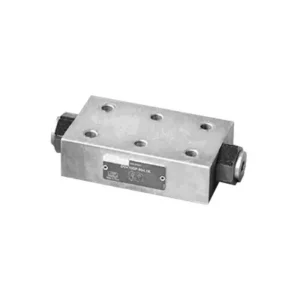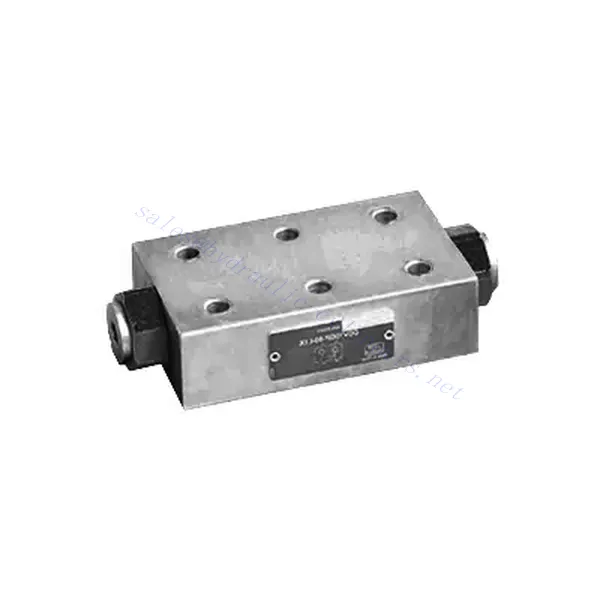DSV Series Pilot Operated Check Hydraulic Valve
DSV Series Pilot Operated Check Hydraulic Valve

The DSV series pilot-operated check hydraulic valve is an innovative solution designed to optimize the performance and control of hydraulic systems. With its advanced design and versatile features, this valve enhances fluid flow management, ensuring efficient and reliable operation.
The DSV series pilot-operated check hydraulic valve is essential for hydraulic systems, offering precise control, high flow capacity, and reliable check functionality. With its pilot-operated design and pressure control capabilities, it optimizes fluid flow and enhances system performance. Following the recommended usage methods and adhering to regular maintenance practices, the DSV series valve will continue providing efficient and reliable operation. Upgrade your hydraulic system with the DSV series pilot-operated check hydraulic valve and experience the benefits of enhanced control and efficiency.
DSV Series Pilot Operated Check Hydraulic Valve Key Characteristics:
- Pilot Operated Design:
- The DSV series valve incorporates a pilot-operated mechanism that enables precise control over fluid flow.
- This design allows for enhanced accuracy and responsiveness, ensuring optimal system performance.
- Check Functionality:
- The valve features a built-in check function that enables unidirectional fluid flow while preventing backflow.
- This ensures system integrity and prevents potential damage, providing peace of mind during operation.
- High Flow Capacity:
- The DSV series valve is engineered to handle high flow rates, making it suitable for efficient fluid control applications.
- Its optimized flow path minimizes pressure drop, maximizing system efficiency and reducing energy consumption.
- Pressure Control:
- This hydraulic valve offers precise pressure control capabilities, allowing for managing pressure levels within the hydraulic system.
- It ensures stability and reliability by maintaining consistent pressure, even under varying load conditions.
DSV Series Pilot Operated Check Hydraulic Valve Parameter:
| Weight | kg | 2.24 |
| Max. operating pressure | bar | 350 |
| Crack pressure | bar | 8 |
| Max. flow-rate | L/min | 50 |
| Flow direction | See the sign | |
| Free flow cracking pressure | bar | Refer to the characteristic curve |
| Area radio | 4:1A1:A2=3.2:1 | |
| Fluid temperature range ℃ | -30 to +80 (NBR seals) | |
| -20 to +80 (FKM seals) | ||
| Fluid | Mineral oil suitable for NBR and FKM seal | |
| Phosphate ester for FKM seal | ||
| Degree of contamination | Maximum permissible degree of fluid contamination: Class 9. NAS 1638 or 20/18/15, ISO4406 | |
DSV Series Pilot Operated Check Hydraulic Valve Advantages:
• Sub-plate mounting sub-plate mounting connection
• Two set of leaking free ports
• Stable cracking pressure
使用方法 DSV Series Pilot Operated Check Hydraulic Valve:
- Pilot Operated Design:
- The DSV series valve incorporates a pilot-operated mechanism that enables precise control over fluid flow.
- This design allows for enhanced accuracy and responsiveness, ensuring optimal system performance.
- Check Functionality:
- The valve features a built-in check function that enables unidirectional fluid flow while preventing backflow.
- This ensures system integrity and prevents potential damage, providing peace of mind during operation.
- High Flow Capacity:
- The DSV Series Valve is engineered to handle high flow rates, making it suitable for applications that require efficient fluid control.
- Its optimized flow path minimizes pressure drop, maximizing system efficiency and reducing energy consumption.
- Pressure Control:
- This hydraulic valve offers precise pressure control capabilities, allowing for managing pressure levels within the hydraulic system.
- It ensures stability and reliability by maintaining consistent pressure, even under varying load conditions.
How To Bleed A Hydraulic Cylinder Without Bleeder Valve?
Bleeding a hydraulic cylinder without a bleeder valve can be more challenging, but it is still possible. Here’s a step-by-step guide on how to bleed a hydraulic cylinder without a bleeder valve:
- Safety Precautions:
- Prioritize safety by wearing appropriate personal protective equipment, gloves, and safety glasses.
- Make sure the hydraulic system is depressurized. Turn off the power source and relieve residual pressure by operating the control valve several times.
- Cylinder Positioning:
- Position the hydraulic cylinder to allow air bubbles to rise to the highest point. This may involve tilting or rotating the cylinder.
- Fill the Cylinder:
- Fill the cylinder with hydraulic fluid through the hydraulic line ports or access points.
- Slowly add the fluid to avoid introducing air bubbles. Allow the fluid to settle and remove any trapped air using the following steps.
- Manual Priming:
- With a cylinder filled with fluid, manually prime or force the air out of the cylinder using the following methods:
- Gently stroke the cylinder’s piston rod back and forth to create pressure and force any trapped air toward the hydraulic line ports.
- You can also tap or lightly strike the cylinder’s body using a rubber mallet or a wooden block to help dislodge air bubbles.
- Fluid Replenishment:
- As you stroke the piston rod or tap the cylinder, keep an eye on the fluid level.
- If the fluid level drops, replenish it with additional hydraulic fluid to maintain proper priming.
- Repeat the Process:
- Continue the manual priming process, stroking the piston rod and tapping the cylinder until no more air bubbles are visible and the cylinder is properly primed.
- Take your time and be patient during this process, as removing all the air may require multiple repetitions.
- System Testing:
- Once you believe the cylinder is adequately bled, reconnect the hydraulic lines and fittings.
- Slowly pressurize the hydraulic system while monitoring for any signs of air bubbles or leaks.
- Operate the cylinder through its full range of motion to ensure smooth operation and check for irregularities.
- Ongoing Maintenance:
- Regularly inspect the hydraulic system for any air accumulation or performance issues.
- If you notice recurring air in the system, it may be necessary to revisit the bleeding process or seek professional assistance to identify and resolve any underlying issues.
工厂的能力和产能:
(1) 装配
我们拥有一流的自主研发装配平台。液压油缸生产车间拥有 4 条半自动提升油缸装配线和 1 条全自动倾斜油缸装配线,设计年生产能力 100 万支。特种油缸车间配备了各种规格的半自动清洗装配系统,设计年生产能力 20 万只,并配备了知名数控加工设备、加工中心、高精度油缸加工专用设备、机器人焊接机、自动清洗机、油缸自动装配机、自动喷漆生产线等。现有关键设备 300 多台(套)。设备资源的优化配置和高效利用,保证了产品的精度要求,满足了产品的高质量需求。


(2) 机加工
加工车间配备了定制的斜轨车削中心、加工中心、高速珩磨机、焊接机器人及其他相关设备,可加工最大内径 400 毫米、最大长度 6 米的气缸管。

(3) 焊接

(4) 油漆和涂料
配备中小型圆筒自动水性漆喷涂线,实现机器人自动上下料和自动喷涂,设计产能为每班 4000 件;
我们还拥有一条由动力链驱动的大型油缸半自动喷漆生产线,设计产能为每班 60 箱。


(5) 测试
我们拥有一流的检验设施和试验台,确保气缸的性能符合要求。

We are one of the best hydraulic cylinder manufacturers. We can offer comprehensive hydraulic cylinders. We also provide corresponding 农用齿轮箱. We have exported our products to clients worldwide and earned a good reputation because of our superior product quality and after-sales service. We welcome customers at home and abroad to contact us to negotiate business, exchange information, and 与我们合作!
参观我们的 VR 工厂
通过以下方式参观我们的 VR 工厂
液压缸应用:


